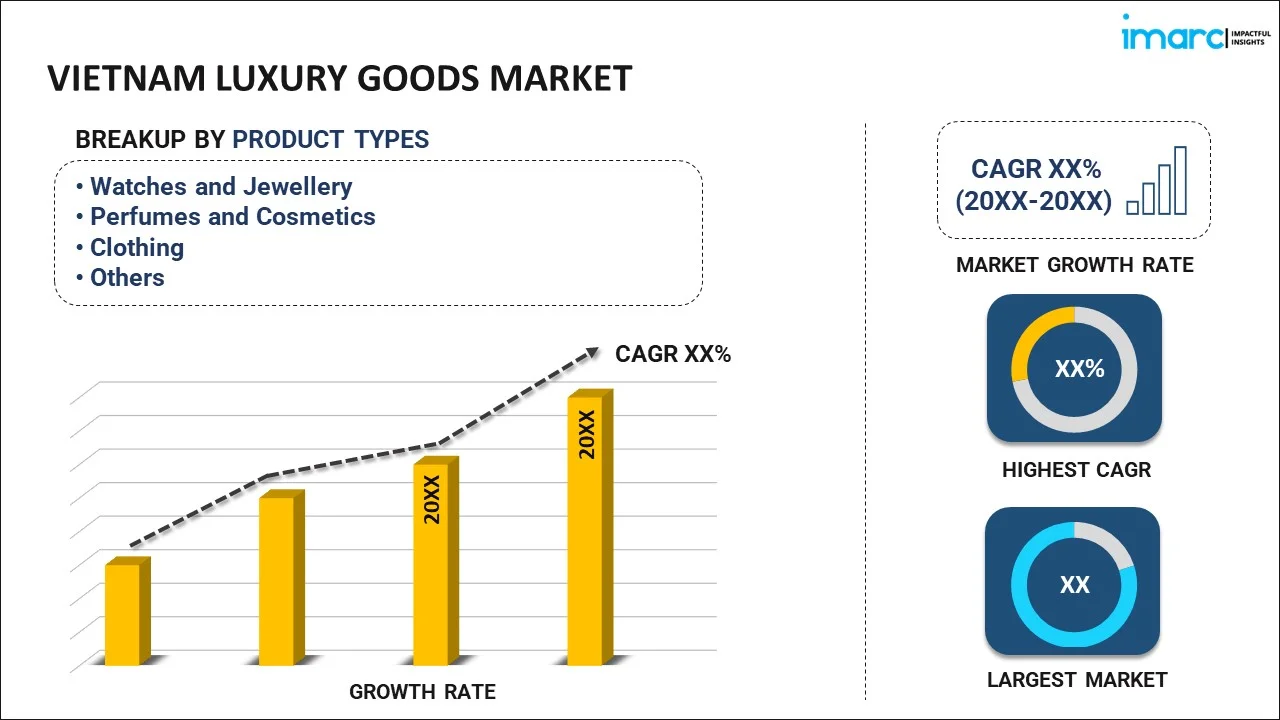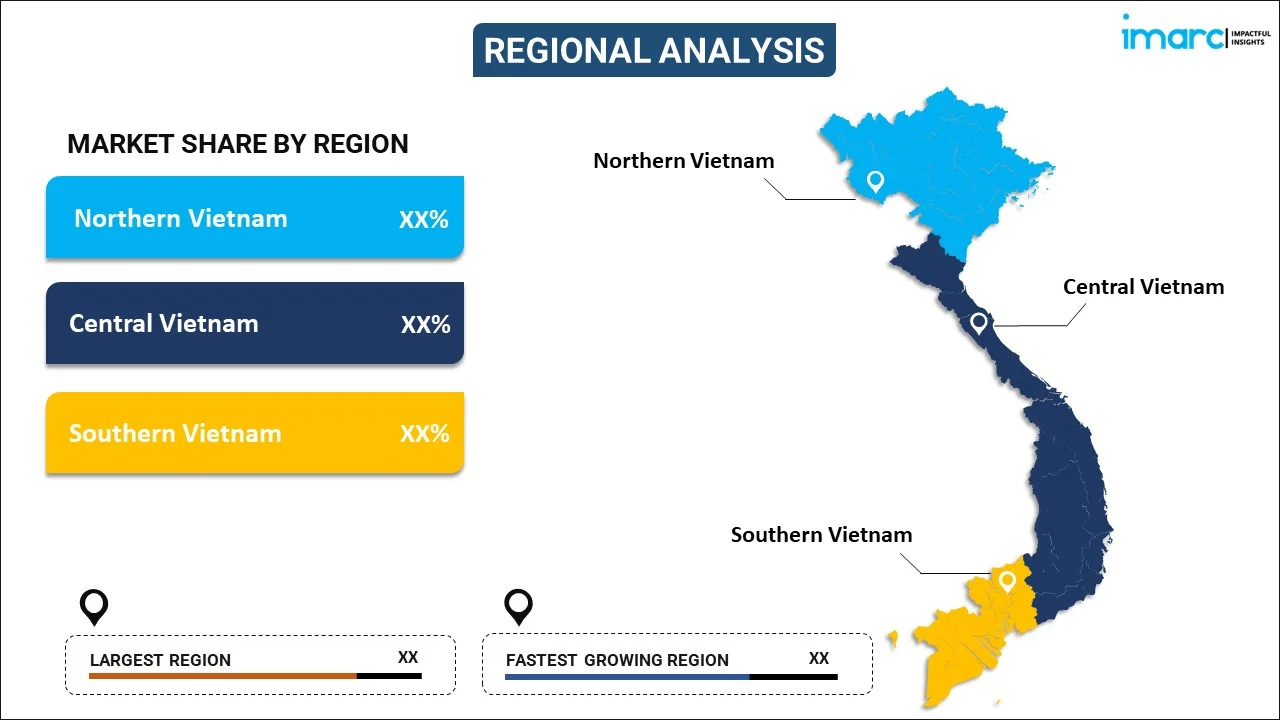
Vietnam Luxury Goods Market Report by Product Type (Watches and Jewellery, Perfumes and Cosmetics, Clothing, Bags/Purse, and Others), Distribution Channel (Offline, Online), End User (Women, Men), and Region 2025-2033
Vietnam Luxury Goods Market Overview:
The Vietnam luxury goods market size reached USD 2.3 Billion in 2024. Looking forward, IMARC Group expects the market to reach USD 4.0 Billion by 2033, exhibiting a growth rate (CAGR) of 7.3% during 2025-2033. The rising disposable income among individuals, the significant expansion in the tours and travel industry, and the growing e-commerce and online platforms offering customers to explore several luxury products represent some of the key factors driving the luxury market in Vietnam. Vietnam's rising middle class is projected to reach 56 Million by 2030, boosting its global ranking from 26th to 18th largest middle‑class population.
|
Report Attribute
|
Key Statistics
|
|---|---|
|
Base Year
|
2024 |
|
Forecast Years
|
2025-2033
|
|
Historical Years
|
2019-2024
|
| Market Size in 2024 | USD 2.3 Billion |
| Market Forecast in 2033 | USD 4.0 Billion |
| Market Growth Rate (2025-2033) | 7.3% |
Luxury goods are products or items that are associated with exceptional quality, exclusivity, and prestige. These items often go beyond basic functionality and are characterized by their high price tags, superior craftsmanship, and the use of premium materials. They include several products, including fashion items, accessories, automobiles, watches, jewelry, electronics, and experiences such as luxury travel and dining. They have limited availability and produce a limited number of items to maintain an air of exclusivity which contributes to their desirability and high price. They also invest heavily in marketing and branding to create a sense of aspiration and status around their products. These products are meticulously crafted, often by skilled artisans who pay close attention to every detail. The materials used are of the highest caliber, whether it's the finest leather for handbags, rare gemstones for jewelry, or precision engineering in luxury cars. The emphasis on quality ensures that luxury items not only look exquisite but also offer superior performance and durability. They are also closely associated with heritage and tradition, and many luxury brands have a long history that spans generations, which adds to the perceived value of their products, allowing consumers to view luxury goods as investments in terms of quality and the status they confer.
Vietnam Luxury Goods Market Trends:
Economic Confidence Sparking Premium Spending
Vietnam’s economic growth and rising wages are lifting more consumers into the luxury buyer category. With more discretionary income, especially in urban hubs, people are rewarding themselves with high-end fashion, accessories, and personal indulgences. The Vietnam luxury market is expanding beyond traditional elites, driven by upwardly mobile professionals and new entrepreneurs. Brands are launching showrooms in second-tier cities, while malls are upgrading their tenant mix to cater to shoppers eager for quality and prestige. This shift has turned luxury into a lifestyle goal rather than a distant aspiration for many first-time buyers.
Affluent Shoppers Fueling Growth in Accessories
As Vietnam’s middle class grows and high-net-worth individuals become more visible, spending on premium personal goods is rising. Buyers in this segment want products that reflect their achievements and personal identity. The jewelry and watches market is benefiting directly, with strong demand for heritage brands, custom pieces, and limited collections. These purchases are seen as investments and status markers. Retailers are adapting with private viewing rooms, concierge services, and exclusive collections tailored for Vietnam’s affluent clientele. The demand is no longer just about logos; it’s about value, rarity, and personalization.
Young Consumers Redefining Fashion Aspirations
The emerging generation of Vietnamese consumers is driving a major shift in luxury preferences. Today’s shoppers want fashion that aligns with their values, i.e., individuality, creativity, and purpose. The Vietnam luxury fashion market is responding by offering collections that emphasize style over formality and story over status. Genderless fashion, local designer collaborations, and capsule drops are gaining popularity. This audience cares as much about how a product fits into their lifestyle as they do about where it was made. Global brands are learning quickly that in Vietnam, relevance now beats tradition.
Digital Platforms Pushing High-End Retail Online
Vietnamese consumers are increasingly shopping for luxury online, using mobile apps and social media to discover and buy. The shift has prompted major brands to improve digital storefronts, partner with local e-commerce platforms, and experiment with livestream selling. The Vietnam fashion market is seeing strong traction in this space, especially with younger buyers. They expect instant access, clear pricing, and responsive service, even for premium products. This digital-first approach is helping brands engage with new audiences who may not visit a physical boutique but still expect a top-tier experience.
Tourism Boosting Luxury Retail at Travel Hubs
Luxury sales are rising in tourist-heavy areas, especially as airports expand and high-end resorts attract wealthier travelers. International visitors often make premium purchases at duty-free shops or resort boutiques. At the same time, affluent local tourists are spending more during domestic vacations. Categories like jewelry in Vietnam are seeing strong demand during weddings, milestone trips, and holidays. Brands are taking note by launching pop-up stores and expanding to tourist destinations like Da Nang and Phu Quoc, where vacation spending is becoming a key revenue stream.
Influence of Celebrities Driving Brand Preference
Vietnamese celebrities and social media influencers are shaping consumer behavior in powerful ways. When a well-known personality is seen wearing or using a luxury product, it often drives immediate interest and sales. This has led to deeper partnerships between talent and fashion houses. Luxury brands in Vietnam are investing in these relationships, building campaigns around local figures who resonate with younger audiences. Influencer marketing now plays a central role in product launches and brand storytelling, making luxury feel more accessible without diluting its exclusivity.
Vietnam Luxury Goods Market Segmentation:
IMARC Group provides an analysis of the key trends in each segment of the market, along with forecasts at the country level for 2025-2033. Our report has categorized the market based on product type, distribution channel, and end user.
Product Type Insights:

To get more information on this market, Request Sample
- Watches and Jewellery
- Perfumes and Cosmetics
- Clothing
- Bags/Purse
- Others
The report has provided a detailed breakup and analysis of the market based on the product type. This includes watches and jewellery, perfumes and cosmetics, clothing, bags/purse, and others.
Distribution Channel Insights:
- Offline
- Online
A detailed breakup and analysis of the market based on the distribution channel have also been provided in the report. This includes offline and online.
End User Insights:
- Women
- Men
The report has provided a detailed breakup and analysis of the market based on the end user. This includes women and men.
Regional Insights:

- Northern Vietnam
- Central Vietnam
- Southern Vietnam
The report has also provided a comprehensive analysis of all the major regional markets, which include Northern Vietnam, Central Vietnam, and Southern Vietnam.
Competitive Landscape:
The market research report has also provided a comprehensive analysis of the competitive landscape. Competitive analysis such as market structure, key player positioning, top winning strategies, competitive dashboard, and company evaluation quadrant has been covered in the report. Also, detailed profiles of all major companies have been provided.
Vietnam Luxury Goods Market News:
- In June 2025, Tokyo Lifestyle Co., Ltd. announced its plans to open a new directly-operated store in Ho Chi Minh City in July 2025. Located on Nguyen Thi Minh Khai Street, a major commercial hub, the store will feature Japanese luxury, beauty, and lifestyle products. This move reflects the company’s strategy to strengthen its footprint in Southeast Asia and boost brand presence in Vietnam’s expanding luxury retail market.
- In February 2025, the Vietnam International Trade Fair for Apparel, Textiles, and Textile Technologies (VIATT) took place from February 26–28. Hosting over 450 exhibitors from 24 countries, including leading European luxury fabric makers, the event highlighted Vietnam’s role as a premium production hub. With a focus on sustainable and digital innovations, VIATT strengthened Vietnam’s position in the luxury textile supply chain across ASEAN and international markets.
Vietnam Luxury Goods Market Report Coverage:
| Report Features | Details |
|---|---|
| Base Year of the Analysis | 2024 |
| Historical Period | 2019-2024 |
| Forecast Period | 2025-2033 |
| Units | Billion USD |
| Scope of the Report | Exploration of Historical Trends and Market Outlook, Industry Catalysts and Challenges, Segment-Wise Historical and Future Market Assessment:
|
| Product Types Covered | Watches and Jewellery, Perfumes and Cosmetics, Clothing, Bags/Purse, Others |
| Distribution Channels Covered | Offline, Online |
| End Users Covered | Women, Men |
| Regions Covered | Northern Vietnam, Central Vietnam, Southern Vietnam |
| Customization Scope | 10% Free Customization |
| Post-Sale Analyst Support | 10-12 Weeks |
| Delivery Format | PDF and Excel through Email (We can also provide the editable version of the report in PPT/Word format on special request) |
Key Benefits for Stakeholders:
- IMARC’s industry report offers a comprehensive quantitative analysis of various market segments, historical and current market trends, market forecasts, and dynamics of the Vietnam luxury goods market from 2019-2033.
- The research report provides the latest information on the market drivers, challenges, and opportunities in the Vietnam luxury goods market.
- Porter's five forces analysis assist stakeholders in assessing the impact of new entrants, competitive rivalry, supplier power, buyer power, and the threat of substitution. It helps stakeholders to analyze the level of competition within the Vietnam luxury goods industry and its attractiveness.
- Competitive landscape allows stakeholders to understand their competitive environment and provides an insight into the current positions of key players in the market.
Key Questions Answered in This Report
The luxury goods market in Vietnam was valued at USD 2.3 Billion in 2024.
The Vietnam luxury goods market is projected to exhibit a CAGR of 7.3% during 2025-2033, reaching a value of USD 4.0 Billion by 2033.
Rising income from economic growth and urbanization, a fast-expanding middle class, and high net-worth individuals, plus booming tourism with duty-free shopping, all fuel demand. Brands tap e-commerce, influencers, sustainability trends and personalized experiences. Premium retail outlets in luxury malls and hotels further drive Vietnam's luxury goods market growth.
Need more help?
- Speak to our experienced analysts for insights on the current market scenarios.
- Include additional segments and countries to customize the report as per your requirement.
- Gain an unparalleled competitive advantage in your domain by understanding how to utilize the report and positively impacting your operations and revenue.
- For further assistance, please connect with our analysts.
 Request Customization
Request Customization
 Speak to an Analyst
Speak to an Analyst
 Request Brochure
Request Brochure
 Inquire Before Buying
Inquire Before Buying




.webp)




.webp)












